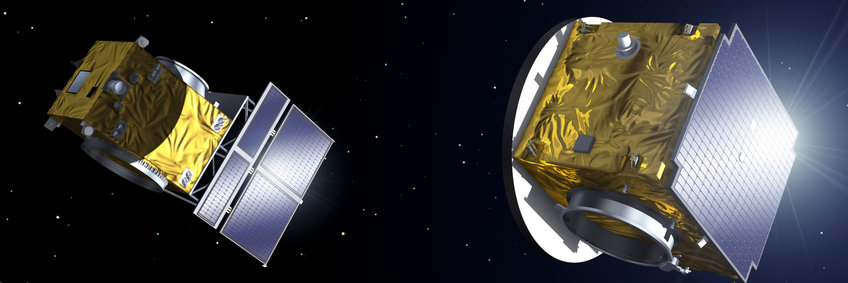
PROBA-3 – A Coronagraph on two Space Probes
The observation of the solar corona has become an important tool in space weather prediction. Sudden eruptions of gigantic plasma clouds (coronal mass ejections) from the solar atmosphere can be detected many hours before these clouds may strike the near-earth environment allowing to take measures for example to protect satellites and astronauts onboard the space station. The operation of coronagraphs from space allows for a continuous solar observations, unperturbed by Earth's atmosphere and has been successfully practiced for 25 years by the SOHO and STEREO missions.
The ASPIICS (Association of Spacecraft for Polarimetric and Imaging Investigation of the Corona of the Sun) coronagraph on ESA's technology mission PROBA-3 (PRoject for On-Board Autonomy) introduces a new generation of these instruments. PROBA-3 will demonstrate for the first time that a coronagraph distributed on two probes orbiting Earth can be operated in formation flight. While traditional coronagraphs block out the bright solar disk with a small occulter in the telescope's beam path to make the much darker solar corona visible, ASPIICS uses a free-flying, second space probe at a distance of 144 meters from the actual corona telescope on the main probe. In order for the main probe to remain exactly in the shadow of the occulter probe, it is necessary to precisely maintain the positions and orientations of the two probes during the flight: the relative position of the probes and their orientation to the Sun must not deviate from the nominal values by more than about one millimeter.
This configuration allows observations of the solar corona from three solar radii to almost the solar limb at 1.1 solar radii. The images will have a resolution of 2.8 arcseconds. The quality of the expected data will approach that of corona observations during a lunar eclipse - with the difference that ASPIICS will observe almost daily. In addition, ASPIICS is equipped with three polarizing filters and three spectral interference filters at wavelengths of 535-565 nanometers (yellow-red continuum) 530 nanometers (emission line of Fe XIV ion), and 588 nanometers (D3 line of He I).
The ASPIICS instrument was designed and is being built by the Centre Spatial de Liège under contract to ESA. A consortium led by the Royal Observatory of Belgium in Brussels is acting as scientific advisors. Currently, the mission is in the construction phase; the ASPIICS coronagraphic telescope is expected to be completed by the end of 2021 and the mission is scheduled to launch early 2023.
MPS is participating in the design and supplying of the complex software pipeline that will compute the highest quality coronal images for scientific analysis from the expected raw data.